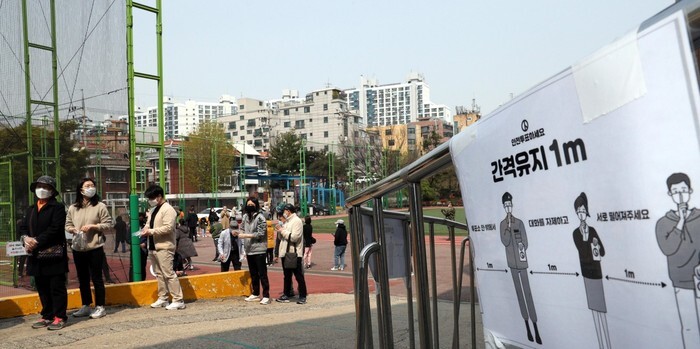hankyoreh
Links to other country sites 다른 나라 사이트 링크
Disease control authorities say weeks following Apr. 15 election are critical for containing COVID-19

A general election to select the members of the 21st National Assembly was held on Apr. 15 amid disease control measures at polling stations to prevent the spread of the novel coronavirus. It was the first time in history an election was held amid disease prevention efforts to stop the spread of a contagion, including compulsory use of masks and plastic gloves and the maintenance of at least one meter’s distance from others. With some calling the election the first major test on the road to a more relaxed approach to disease prevention, disease prevention authorities said they would be observing the virus transmission situation associated with the election for the next two weeks or so.
For the election on Apr. 15, a considerable additional investment of staff and budget was made in comparison with past elections in order to prevent the coronavirus from spreading. The National Election Commission (NEC) said it had spent a budget of 22 billion won (US$17.9 million) in connection with the virus, including around 17.6 billion won (US$14.3 million) toward hand sanitizer at polling stations and masks for election clerical officials to wear as well as 5 billion won (US$4.1 million) from the commission’s own budget. With temperature checks and other additional duties at the stations, the number of voting management and clerical staff was 26,602 more than for the last election. During the 20th general election, the voting management and clerical staff totaled 132,179 people; during the 21st, the number of workers stood at 158,781. A large number of local government employees followed closely to allow voters in self-isolation to cast their ballots.
Despite the all-out efforts made to prevent infection at polling stations, disease control authorities see a continued risk of community transmission through “silent spreaders,” asymptomatic cases, who have yet to be detected. While intensive social distance practices remain in place through Apr. 19, the election necessarily resulted in a large increase in movement nationwide. The Korea Centers for Disease Control and Prevention (KCDC) said, “We’re going to need to watch the 10 to 14 days after voting before we start resting easy.”
While disease prevention authorities had been holding two regular briefings daily since Jan. 28, including weekends and holidays, no briefing was held on Apr. 15. The KCDC opted not to hold one because of the election. Instead, they only announced statistics on newly diagnosed cases. The KCDC reported 22 new cases for Apr. 16, bringing the cumulative total to 10,613. The newly diagnosed cases were found primarily in North Gyeongsang Province and Gyeonggi Province (four each), Daegu (four), and Busan (three). Apart from the total of 53 on Apr. 8, the number of new cases diagnosed has remained below 50 per day since last week.
By Choi Ha-yan and Jang Na-rye, staff reporters
Please direct comments or questions to [english@hani.co.kr]

Editorial・opinion
![[Column] Season 2 of special prosecutor probe may be coming to Korea soon [Column] Season 2 of special prosecutor probe may be coming to Korea soon](https://flexible.img.hani.co.kr/flexible/normal/500/300/imgdb/original/2024/0426/3317141030699447.jpg) [Column] Season 2 of special prosecutor probe may be coming to Korea soon
[Column] Season 2 of special prosecutor probe may be coming to Korea soon![[Column] Park Geun-hye déjà vu in Yoon Suk-yeol [Column] Park Geun-hye déjà vu in Yoon Suk-yeol](https://flexible.img.hani.co.kr/flexible/normal/500/300/imgdb/original/2024/0424/651713945113788.jpg) [Column] Park Geun-hye déjà vu in Yoon Suk-yeol
[Column] Park Geun-hye déjà vu in Yoon Suk-yeol- [Editorial] New weight of N. Korea’s nuclear threats makes dialogue all the more urgent
- [Guest essay] The real reason Korea’s new right wants to dub Rhee a founding father
- [Column] ‘Choson’: Is it time we start referring to N. Korea in its own terms?
- [Editorial] Japan’s rewriting of history with Korea has gone too far
- [Column] The president’s questionable capacity for dialogue
- [Column] Are chaebol firms just pizza pies for families to divvy up as they please?
- [Column] Has Korea, too, crossed the Rubicon on China?
- [Correspondent’s column] In Japan’s alliance with US, echoes of its past alliances with UK
Most viewed articles
- 1AI is catching up with humans at a ‘shocking’ rate
- 2After election rout, Yoon’s left with 3 choices for dealing with the opposition
- 3Is Japan about to snatch control of Line messenger from Korea’s Naver?
- 4No good, very bad game for Korea puts it out of Olympics for first time since 1988
- 51 in 5 unwed Korean women want child-free life, study shows
- 6Will NewJeans end up collateral damage in internal feud at K-pop juggernaut Hybe?
- 7Korea’s 1.3% growth in Q1 signals ‘textbook’ return to growth, says government
- 8Marriages nosedived 40% over last 10 years in Korea, a factor in low birth rate
- 9[Editorial] Japan’s rewriting of history with Korea has gone too far
- 10Why Korea shouldn’t welcome Japan’s newly beefed up defense cooperation with US